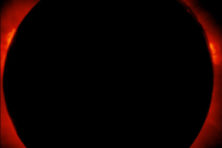Full Moon
- Share
- Tweet
- Pin
- Share

The moon over Lake Michigan, taken with a spotting scope and a digital camera. Photo by Roy Lukes.
I’m quick to thank my lucky stars for being born (Aug. 5, 1929) and raised in a small town (Kewaunee, WI) where bright city lights hardly existed and where we could enjoy and be held in awe at the brilliant, dark, nighttime skies.
There was a small gentle slope of around two feet between our neighbors to the south and our property. As we’d comfortably lie there, facing north, the dark sky, the Milky Way, bright stars and the Big Dipper greeted us with open and welcoming arms.
The south beach at Kewaunee proved to be our constant free-for-the-using companion on many summer nights, especially when the moon was full. Fortunately the full moon always appears shortly after sunset so, by word of mouth, four or five of us guys would each bring a potato from home, a few matches, and naturally we all carried our own trusty jackknife.
Often we’d meet right after supper outside Bodecker’s Drugstore at the main intersection in downtown Kewaunee, corner of Ellis and Milwaukee St., at the base of the steep hill. How we enjoyed sitting against the warm west wall of the dark brown brick building, thoroughly heated by the afternoon sun, and watching toward the west to see hundreds of Chimney Swifts circling the tall Kewaunee Brewery chimney as one by one they’d drop downward into their vertical nesting sites and roosts. That landmark chimney is still there and, yes, the Chimney Swifts continue to use it each summer!
About the time the Swifts’ performance was completed we’d head for the beach, hike southward about a mile and prepare for our full moon activities, simple as they were. First a six-inch-deep, two-foot-wide basin was scooped in the sand. Our potatoes were buried beneath an inch or so of the sand. On top of our future “feast” a bonfire of dry driftwood was lighted, and then it was time to go skinny-dipping.
Heck no we wouldn’t bring towels or bathing suits with us. A half hour or more of swimming and typical horseplay and it was time to gather around the fire to warm up and dry off. Carefully, one at a time, we’d gently push the fire and coals off where our potato was buried, dig out and ease the “black object” onto dry sand to let it cool a bit. Cut in half, you have no idea how delectable those potatoes were—no butter, no salt, just scrumptious “deep pit” potato flavor.

Photo by Roy Lukes.
For some reason the Harvest Moon, creeping above the horizon and forming a sea of diamonds toward whoever was watching it, always appeared much bigger than other full moons during the year. Technically the Harvest Moon comes soon after or before the autumnal Equinox, when the sun is directly above the equator. It is at this time of the year that the moon rises at its shallowest angle to the horizon, which makes it appear larger and also amplifies it image.
It’s the moonlight passing through a greater amount of atmospheric particles (dust and various pollutants) shortly after rising that produces its spectacular warm reddish color. No doubt this feature inspired the vaudeville team of Nora Bayes and Jack Norworth in the early 1900s to produce the continually popular and well-loved song, “Shine On, Harvest Moon.”
As to the apparent size of the moon, here’s something you can easily try at home, to prove once and for all time that the full moon during any month of the year is not nearly as big in the sky as meets the eye. Make separate tracings on a stiff piece of white paper a dime, penny, nickel, quarter and half dollar – and even a silver dollar if you have one. It’s up to you to guess which of these coins, when placed six feet away from your eyes is closest in size to the size of the full moon as it appears in the sky
My estimate is that practically every one of my students in past years chose either the half dollar or silver dollar to be the correct size. Surely you’ve guessed by now that the correct size is – the dime! I’ve carefully made accurate cut-outs of each coin, attached them to thin stiff pieces of wire, and had someone hold them, one at a time, exactly six feet from my eyes, next to and actually right over the moon – and the dime always wins!
The autumn season is a perfectly wonderful time of the year to enjoy the night sky. Its cooler, fewer pesky insects will bother you, the moisture level is lower, and frequently the air is cleaner. Don’t overlook the offerings of the excellent Door Peninsula Astronomical Society (DPAS) at the Crossroads at Big Creek near Sturgeon Bay. They have outstanding equipment to share and very skilled teachers to help you. Their excellent and informative website is http://www.doorastronomy.org.
The constellation that rates as one of my favorites each year during this season, simply because of its relatively low position in the eastern sky, is the Pleiades, also known as the “Seven Sisters.” The next clear night I will plan to try to capture a useable digital image of this world famous star cluster for a future story. The moon images in my current story were taken with a small four megapixel camera attached to an 80 mm spotting scope which in turn was mounted on a sturdy tripod. Very low power is ideal for both the full moon and the Pleiades.
Bake a potato in the sand beneath a small bonfire, perhaps do some skinny dipping, estimate the apparent size of a full moon, but above all, work hard to keep our valuable night sky DARK, full of “diamonds” and other treasures to learn about and to enjoy!

